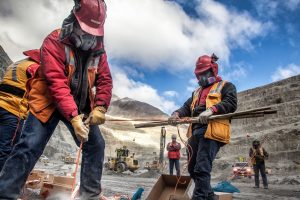 Print a Sign-In Sheet | Spanish Version Coming Soon
Print a Sign-In Sheet | Spanish Version Coming Soon
Back injuries account for about one-fourth of the lost-time injuries in the mining industry. Many of these injuries could be avoided if miners practiced a few basic and simple rules for back conservation.
The back is a complex system consisting of five distinct spinal regions. The lumbar spine – those five vertebrae and six discs in the curved portion of the lower back – is the part injured most often. Lifting, bending, and twisting motions (on or off the job) can cause severe injury and pain. Because the lumbar region is the back area at greatest risk during normal work, it deserves to be the main focus of back conservation and maintenance attention.
Lumbar Conservation
Try to minimize the need to move materials manually. Proper planning and good job design can eliminate much lifting. The use of mechanical lifting aids can be a back-saver. However, if you must lift, remember that your body is not a crane; your back is not designed to “boom up,” “boom down,” or “boom to the side” with ease.
Therefore, when lifting and carrying a load:
- Examine the load for grease, oil, sharp edges, and other hazards.
- Know your limit and halve it; estimate the weight and divide the load or get help if the weight is more than you can comfortably handle.
- Plan your path and make sure that it is free of obstructions.
- Consider how you will set down the load before you lift it.
- Stand close to the load with your feet spread apart (at about shoulder width) with one foot in front of the other for balance.
- Do not twist your body to get into position.
- Squat down and tuck in your chin while keeping your back as straight as possible.
- Grasp the load firmly.
- Lift with your legs by slowly straightening them.
- Return your back to a vertical position.
- Turn only with your feet; do not twist your torso while you are lifting or carrying a load.
Avoid, if possible, lifting a load from below your knee level or from above your shoulder level; both maneuvers, unless done carefully, create great stress on the discs in the lumbar region.
Carry the load close to your body. If possible, avoid any lift where the load’s center of gravity is more than a few inches out from your belly; the stress on the lumbar region multiplies quickly as the center of gravity moves out from the spine.
The “squat down, lift with the legs” maneuver does not come naturally to most miners and is more tiring than the traditional bent-back lifting technique. Yet, its one great virtue – protection of the lumbar spine – makes it a maneuver well worth the extra effort.
And remember the old refrain: “The human body is not a crane.”
While mucking (shoveling), remember:
- Make certain that the material is loose.
- Do not overload your shovel.
- Bend your knees and hips.
- Keep your back in reasonably straight alignment.
- Use a long-handle shovel if space permits.
Lumbar Maintenance
Exercise your back regularly; back conditioning starts with body conditioning. The torso muscles are all interconnected; you must strengthen all of them to help your back. Concentrate on the exercises that strengthen each side equally, for example, low-impact aerobics, high-speed walking, rowing, and swimming. Machines that allow you to simulate rowing, stair-climbing, or cross-country skiing at home are useful for back conditioning. Exercises that strengthen the lifting power of the legs can help the back by allowing the legs to do more of the heavy lifting.
Be wary of activities with many sudden changes of direction or unnatural twisting, such as tennis and golf. Even runners may injure their backs, especially if they don’t do enough stretching. Tobacco smoking diminishes the supply of oxygen and nutrients to the disks that cushion the vertebrae. Thus, smokers are at increased risk of back trouble. Eliminate or at least diminish your use of tobacco; your back will be the better for it.
KEMI does not assume liability for the content of information contained herein. Safety and health remain your responsibility. This information is to be used for informational purposes only and not intended to be exhaustive or a substitute for proper training, supervision, or manufacturers’ instructions/recommendations. KEMI, by publication of this information, does not assume liability for damage or injury arising from reliance upon it. Compliance with this information is not a guarantee or warranty that you will be in conformity with any laws or regulations nor does it ensure the absolute safety of any person, place, or object, including, but not limited to, you, your occupation, employees, customers, or place of business.

